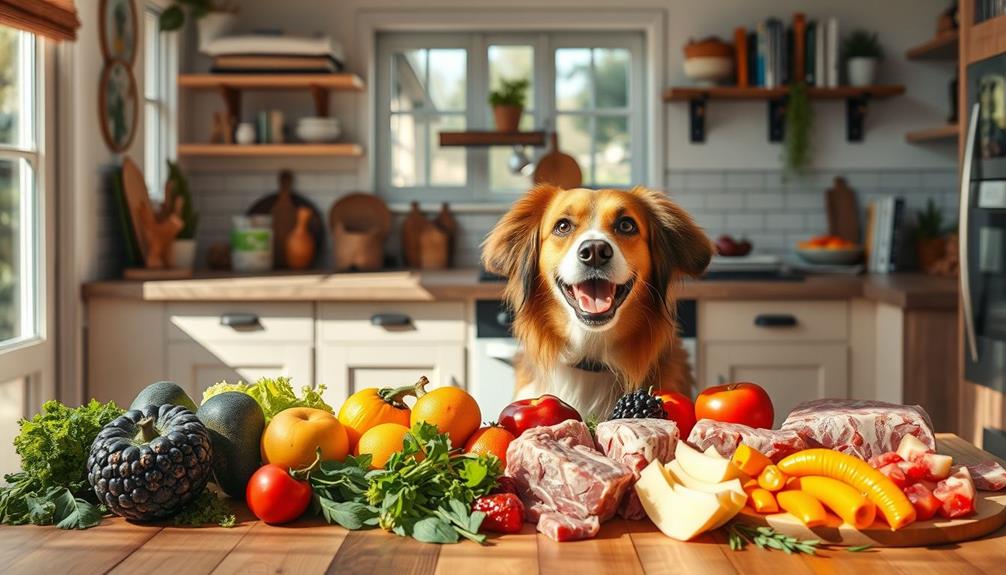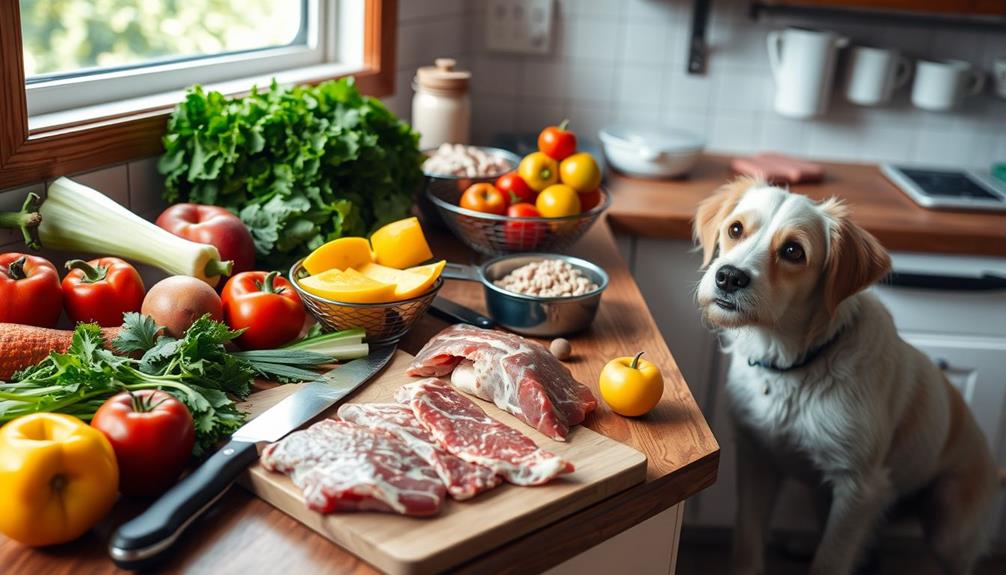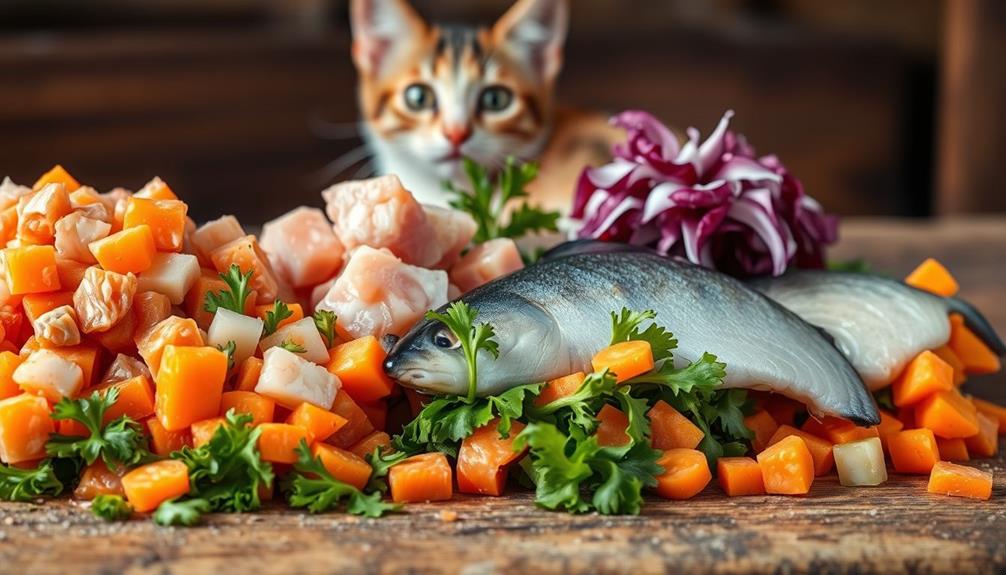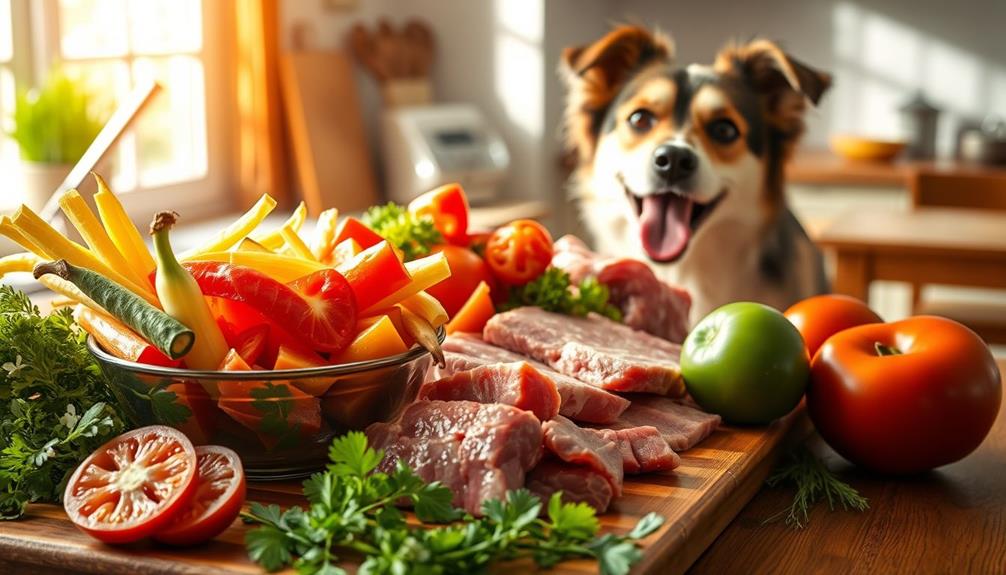Raw food diets for dogs can be beneficial, improving coat health and boosting energy levels. However, experts warn about significant risks, such as bacterial contamination and nutritional imbalances. Dogs fed raw diets can face health issues, particularly if the meals lack essential nutrients or if they're handled improperly. It's essential to consult veterinary nutritionists to make sure your dog's diet meets its specific needs. While many pet owners report positive changes, a cautious approach combined with professional guidance is critical. If you're curious about balancing risks and benefits, there's plenty more to discover on this topic.
Key Takeaways
- Raw food diets can improve coat condition and energy levels, but benefits vary and thorough research is limited.
- Health risks include bacterial contamination from raw meat, posing dangers to both dogs and humans.
- Nutritional imbalances may occur in homemade raw diets, leading to long-term health issues if not properly managed.
- Expert opinions caution against raw diets, emphasizing the importance of veterinary consultation for balanced nutrition.
- Safe handling practices are essential to minimize contamination risks and ensure the well-being of both pets and households.
Understanding Raw Food Diets
When considering a raw food diet for your dog, it's important to understand what it really entails. Raw food diets typically consist of uncooked meat, offal, bones, and may include fruits and vegetables. The aim is to replicate your dog's ancestral eating habits.
While some proponents claim potential benefits like improved coat condition and increased energy levels, you should be aware of the challenges these diets present. It's also vital to remember that just like with human diets, moderation is key to prevent health issues, as certain raw ingredients may pose risks similar to those seen with ice cream and health considerations.
Feeding your dog a raw diet requires careful planning to meet their nutritional requirements. Achieving balanced diets can be tricky with homemade meals, and it's essential to consult with veterinary nutritionists to guarantee your dog gets the right nutrients.
Veterinary organizations, including the World Small Animal Veterinary Association, warn about the health risks associated with raw feeding. These include the possibility of nutritional deficiencies and exposure to harmful bacteria such as Salmonella and E. coli. These bacteria can pose serious health risks not only to your dog but also to your family.
Potential Benefits of Raw Diets
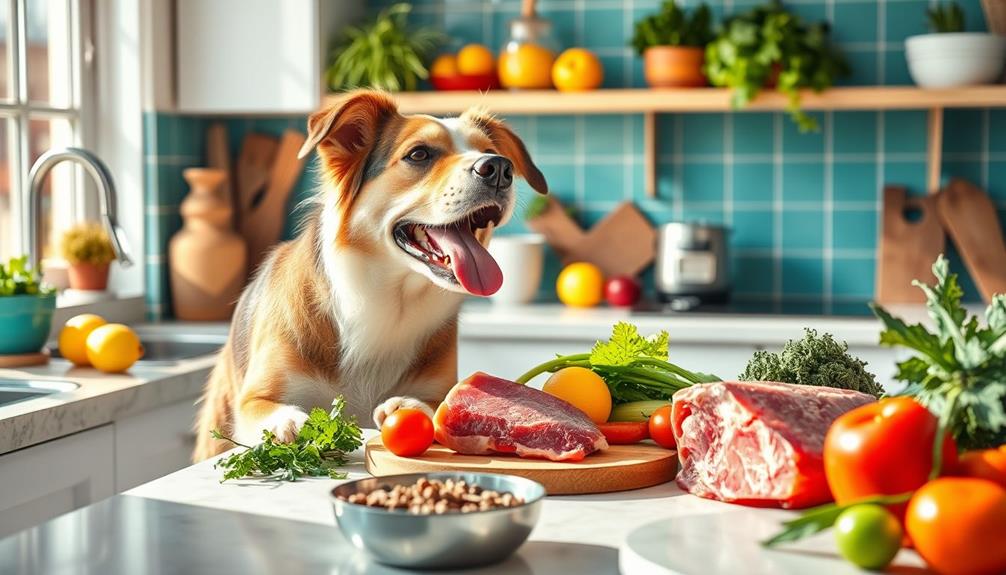
When you switch your dog to a raw diet, you might notice an improvement in their coat condition and a boost in energy levels.
Many pet owners report that their dogs have shinier fur and seem more vibrant after making the change. These benefits could be linked to a diet that aligns more closely with your dog's natural eating habits, which is similar to the way certain cold medications can improve symptoms when they match the body's needs.
Additionally, a raw diet may help with digestion and overall health, further enhancing your dog's well-being.
Improved Coat Condition
Shifting to a raw food diet can lead to noticeable improvements in your dog's coat condition. Many pet owners have reported that their dogs develop shinier coats after making the switch, often attributing this change to the fundamental nutrients found in raw meats and fats.
The higher protein content in raw diets is believed to support skin health, helping to enhance overall coat quality. Additionally, raw foods typically contain increased levels of omega-3 and omega-6 fatty acids, which are essential for promoting a glossy coat and reducing skin issues.
These fatty acids can help nourish your dog's skin, making it healthier and less prone to irritations. This diet also provides natural enzymes that aid digestion, contributing to overall health and wellness, which can reflect in a dog's coat condition benefits of raw food.
While there's plenty of anecdotal evidence from dog owners supporting these claims, it's important to remember that thorough scientific research on this topic remains limited.
When considering a raw food diet, it's important to balance the benefits against potential risks. If you decide to change your dog's diet, keep a close eye on their coat condition and overall health to make sure you're making the best decision for your furry friend.
Enhanced Energy Levels
Many dog owners report that their pets experience enhanced energy levels after switching to a raw food diet. This boost in vigor is often attributed to the higher protein and fat content found in raw meat compared to processed foods.
Additionally, the incorporation of a balanced diet, similar to the principles of effective strategies for weight loss, can also contribute to overall health. Many active breeds show noticeable improvements in stamina and overall health when they shift to a raw meat-based diet.
Here are some potential benefits of enhanced energy levels from a raw diet:
- Increased Stamina: Dogs may enjoy longer play sessions and more enthusiasm during walks.
- Better Nutrient Absorption: The digestibility of raw food allows dogs to convert nutrients into energy more efficiently.
- Muscle Mass Support: A raw diet helps maintain and build muscle, contributing to improved energy levels.
- Sustained Energy: Raw diets may enhance metabolic health, leading to a more consistent energy supply throughout the day.
Health Risks of Raw Feeding

While raw feeding can seem appealing, it comes with significant health risks you should consider. Bacterial contamination from pathogens like Salmonella can affect both your dog and your family.
Furthermore, ensuring your pet receives a proper diet is critical; just as with hamsters, a balanced approach to nutrition is essential for overall health proper diet for hamsters.
Additionally, ensuring your pet gets a balanced diet can be challenging, especially for those with compromised immune systems who may be more vulnerable to these dangers.
Bacterial Contamination Risks
Raw feeding can present significant bacterial contamination risks for both dogs and their owners. Raw meat is known to harbor pathogenic bacteria such as Salmonella and E. coli, which can lead to serious health risks if proper hygiene practices aren't followed.
Even healthy dogs can suffer from gastrointestinal issues after infection. This is especially concerning for immunocompromised pets, who are more vulnerable to severe illness caused by these bacteria. Additionally, maintaining a balanced budget for pet feeding can help guarantee that you're providing nutritious options while managing potential health risks effectively.
To minimize the dangers, consider the following:
- Always wash your hands thoroughly after handling raw meat.
- Clean surfaces with disinfectant to prevent cross-contamination.
- Store raw food securely to avoid attracting pests.
- Monitor your dog's health and consult a vet if you notice any unusual symptoms.
Fecal contamination from dogs on raw diets can also transfer harmful bacteria to humans, potentially resulting in food-borne illness, dehydration, or hospitalization.
Experts stress the importance of maintaining strict hygiene practices to reduce the risk of bacterial transmission, guaranteeing both you and your dog stay healthy. Prioritizing cleanliness is key to enjoying the benefits of raw feeding while minimizing its potential dangers.
Nutritional Imbalance Concerns
Nutritional balance is essential for your dog's health, and raw feeding can sometimes lead to serious imbalances. If you're considering a raw diet, it's important to understand that homemade raw diets often lack critical essential nutrients, including important calcium and phosphorus. A study by Dr. Lisa M. Freeman highlights the potential long-term health risks associated with improperly balanced raw meals.
Additionally, just as in human development, environmental interactions, such as diet, play a significant role in overall health and well-being, and key domains of development in psychology can be applied to understanding nutritional needs.
You should also be cautious with high-protein raw diets, especially if your dog has pre-existing kidney or liver issues, as these can exacerbate health conditions. For puppies, incorrect calcium and phosphorus ratios can lead to bone deformities, impacting their growth and development.
To avoid these nutritional imbalances, seeking vet guidance is essential when changing to a raw diet. A veterinarian can help guarantee that your dog receives the right balance of nutrients and can provide strategies to prevent gastrointestinal upset that might occur due to abrupt dietary changes.
Safety for Vulnerable Individuals
Feeding dogs a raw diet can pose significant health risks, especially for households with young children, elderly individuals, or those with weakened immune systems. The potential for bacterial contamination from raw meat, like Salmonella and E. coli, can lead to serious health problems for both pets and humans. This is particularly concerning for vulnerable populations.
Additionally, the importance of proper food storage and handling is vital to mitigate these risks, as poor practices can exacerbate contamination issues. Engaging in practices similar to mastering the art of bug out bags can help guarantee that all pet food is handled safely and effectively.
Consider these risks when feeding their dogs raw diets:
- Bacterial Contamination: Raw meat can harbor harmful bacteria that may spread in your home.
- Fecal Transmission: Dogs consuming raw food can contaminate surfaces, increasing the risk of bacteria transmission to humans.
- Weakened Immune Systems: Pets with compromised immune systems are at higher risk for food-borne illnesses.
- Public Health Concerns: Outbreaks of bacteria from raw diets can raise public health issues, affecting not just your family but others too.
To minimize these risks, practicing good hygiene is essential. Always wash your hands thoroughly and clean surfaces after handling raw pet food.
Expert Research and Opinions

When considering a raw food diet for your dog, it's vital to weigh the expert research and opinions surrounding the topic. While some advocates tout the benefits of raw dog food, many veterinary experts caution against the potential risks.
The American Veterinary Medical Association warns that raw diets mightn't provide balanced nutrition and can lead to deficiencies if not properly formulated. Additionally, the World Small Animal Veterinary Association highlights significant health risks, such as exposure to pathogenic bacteria like Salmonella and E. coli.
Understanding the potential health consequences is important for responsible pet ownership, especially if considering a diet linked to emotional dysregulation in humans.
Research shows high levels of Enterobacteriaceae found in raw meat samples, indicating contamination risks. Although some proponents claim various benefits of feeding a raw diet, the evidence supporting these claims is limited.
Many experts emphasize that the potential health risks often outweigh the purported advantages.
To protect your dog's health and well-being, it's vital to consult with a veterinarian before making any dietary changes. They can help assess your dog's specific nutritional needs and guide you in minimizing health risks associated with raw diets.
Ultimately, expert advice is invaluable in making informed decisions for your furry friend.
Nutritional Guidelines for Dogs

Providing your dog with a well-balanced diet is vital for their overall health and longevity. As a pet owner, you need to guarantee that your dog's meals contain the right proportions of proteins, fats, carbohydrates, vitamins, and minerals. This helps prevent nutritional deficiencies and supports peak health.
Understanding the potential financial considerations for elderly care can also help you allocate resources effectively for your pet's nutrition.
To achieve complete and balanced diets, consider the following guidelines:
- Consult veterinary guidance to tailor your dog's diet based on their age, breed, and activity level.
- Incorporate high-quality proteins to support muscle health and energy levels.
- Verify you're including essential vitamins and minerals to promote overall well-being.
- Monitor your dog's health regularly to adjust nutritional needs as they change.
While raw pet food can be an option, it's essential to guarantee it meets all nutritional standards. The Association of American Feed Control Officials (AAFCO) provides guidelines that can help pet owners formulate diets that are appropriate for dogs.
Always work with your veterinarian when considering homemade diets to ensure they're nutritionally adequate and adhere to dietary recommendations. This approach will help you provide the best care for your furry friend.
Safe Handling of Raw Food
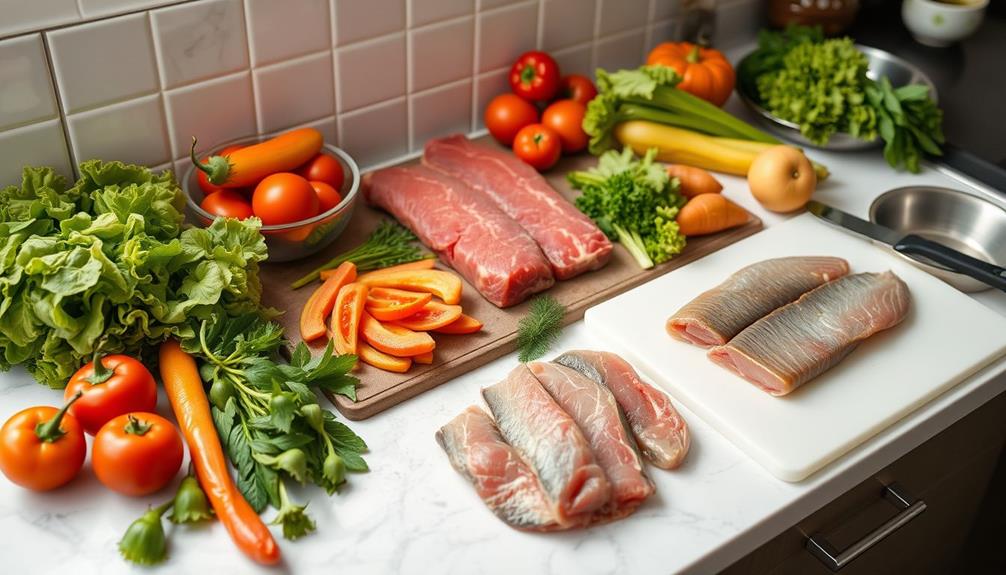
Raw dog food requires careful handling to keep both your pet and your household safe from harmful bacteria. Proper handling is vital to prevent bacterial contamination, as all uncooked meat can harbor pathogens like Salmonella and E. coli.
To guarantee safe handling of raw food, prepare it in designated areas separate from kitchen surfaces. This avoids cross-contamination with human food, which can lead to serious health risks.
After handling raw pet food, thorough handwashing with soap and water is essential. This simple step greatly reduces the risk of transmitting harmful bacteria to yourself and your family.
Additionally, make it a habit to clean and disinfect surfaces, utensils, and feeding bowls used for raw food. This practice helps minimize the spread of bacteria in your home environment.
While feeding your dog raw food, keep a watchful eye on them. Monitoring your pet during meals can help prevent choking hazards, particularly with raw bones.
Alternative Diet Options

Exploring alternative diet options for your dog can lead to a healthier, more balanced lifestyle. While raw diets are popular, they come with health risks such as bacterial contamination and nutritional imbalances.
To guarantee your dog gets the right nutrients, consider these alternatives:
- Fresh food services that provide balanced meals made from natural ingredients, adhering to AAFCO standards.
- Subscription-based meal plans that let you customize recipes, portion sizes, and delivery frequencies to meet your dog's specific needs.
- Kibble diets, which are convenient, but require careful selection to guarantee high-quality ingredients, ideally with protein as the first ingredient.
- Homemade raw diets that necessitate veterinary guidance to guarantee nutritional adequacy, especially for dogs with specific health concerns.
These alternative diet options can help you maintain your dog's health and well-being while minimizing risks.
Always consult your veterinarian before making significant changes to your dog's diet, particularly if you're considering a raw diet or homemade meals. This way, you can provide your furry friend with balanced meals tailored to their needs.
Veterinary Perspectives on Raw Diets
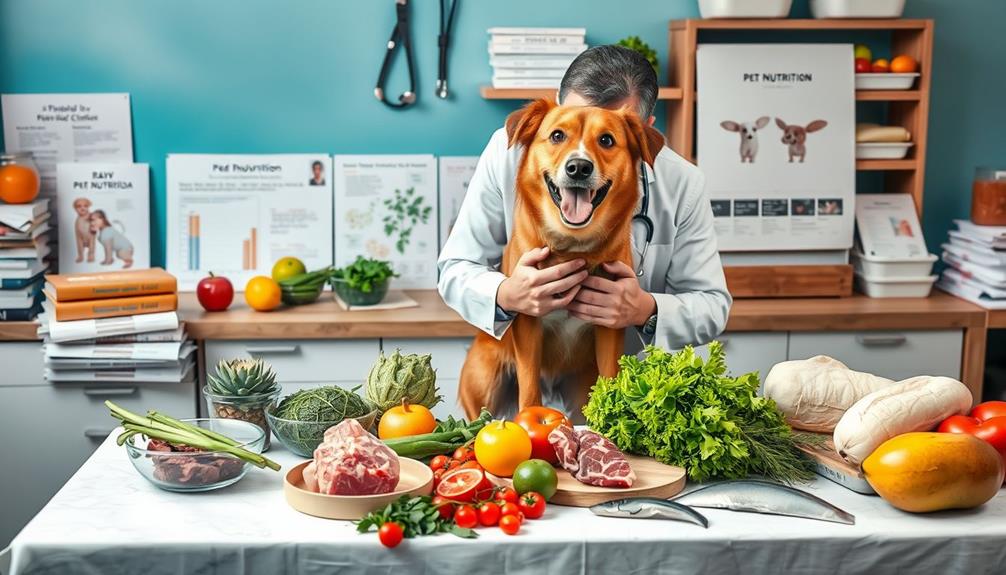
Veterinarians often raise red flags about raw diets for dogs, citing significant health risks. Major veterinary organizations, like the World Small Animal Veterinary Association, express concerns about the potential dangers of feeding your pet raw food.
Raw meat can harbor harmful bacteria, such as salmonella and E. coli, which pose serious health risks not just for dogs but also for their human handlers.
Veterinarians recommend strict hygiene practices when handling raw pet food. This includes regular handwashing and sanitizing surfaces to prevent cross-contamination.
In addition, the American Veterinary Medical Association advises you to consult with veterinarians before changing to raw diets. They can help you guarantee nutritional adequacy and health safety for your furry friend.
Many veterinarians document their concerns about raw feeding in medical records, informing clients of the potential risks and tracking any health issues that arise from diet changes.
While some pet owners advocate for raw diets, it's essential to weigh these considerations carefully. Understanding the potential health risks and nutritional imbalances can help you make informed decisions about your dog's diet.
Always prioritize your pet's health by consulting with a professional.
Making Informed Feeding Choices
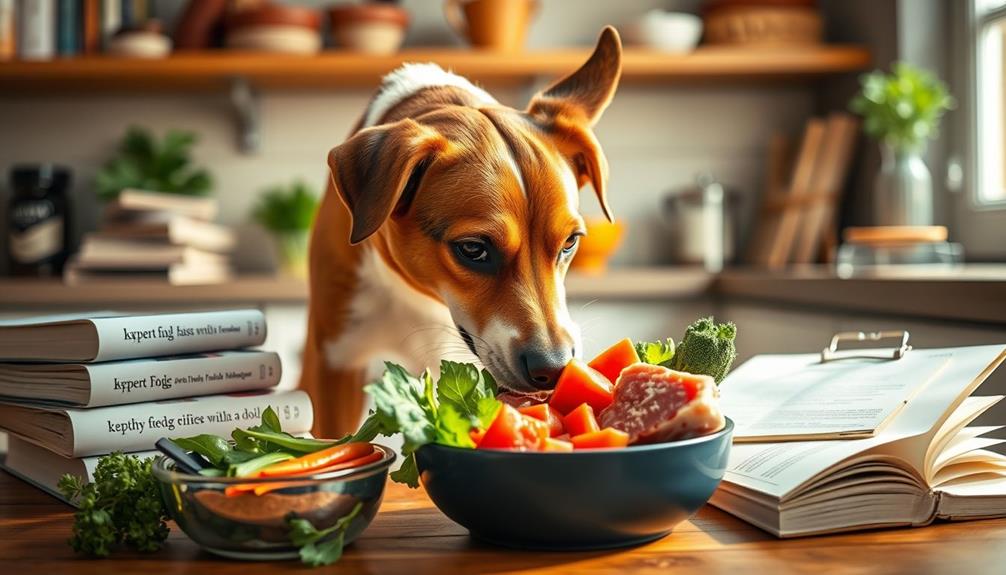
Choosing the right diet for your dog is essential for their overall health and well-being. When weighing the option of feeding a raw meat food diet for dogs, it's imperative to make informed choices. Owners are choosing this path for various reasons, but understanding the potential risks and benefits is significant.
Here are some points to reflect on:
- Consult with your veterinarian for medical advice tailored to your pet's individual health conditions.
- Be aware of the risks associated with raw diets, such as exposure to harmful bacteria like Salmonella and E. coli.
- Ascertain the diet is balanced and meets your dog's nutritional needs; raw diets can often lack essential nutrients.
- Implement stringent hygiene measures when handling raw food to prevent cross-contamination in your home.
Taking these steps can help you decide if a raw food diet is suitable for your furry friend.
Always prioritize your dog's health by reflecting on their unique requirements and seeking professional guidance. With the right approach, you can provide a diet that supports their well-being while minimizing potential risks.
Frequently Asked Questions
What Do Vets Say About Raw Dog Food?
Veterinarians often caution against raw dog food, emphasizing potential nutritional imbalances and health risks from bacteria. They recommend consulting with them before making any dietary changes to guarantee your dog's safety and nutritional needs are met.
Is Raw Food Actually Better for Dogs?
You might wonder if raw food's actually better for dogs. While some owners swear by it, risks like bacterial infections and nutritional imbalances can jeopardize your dog's health. Always consult your vet before making changes. It’s important to remember that not all dogs will thrive on a raw food diet. Some may have trouble digesting raw meat or may develop allergies to certain types of raw foods. Additionally, a raw food diet for dogs may not provide all of the essential nutrients that your pet needs to stay healthy. Your vet can help you determine if a raw food diet is the right choice for your furry friend and can provide guidance on how to safely transition to a raw food diet if it is appropriate for your dog.
What Is the Disadvantage of Raw Dog Food?
Imagine your dog getting sick from Salmonella after eating raw food. The disadvantages of raw dog food include potential bacterial contamination, nutritional imbalances, and risks from whole bones, which can cause choking or serious injuries.
Why Can't Dogs Eat Raw Food?
Dogs can't eat raw food due to the risk of harmful bacteria like Salmonella and E. coli. Improper handling can lead to severe illness, especially for dogs with weakened immune systems or existing health issues.
Conclusion
In the end, choosing a raw food diet for your dog isn't a one-size-fits-all solution. While there are potential benefits, the risks can't be ignored, either. It's essential to weigh the pros and cons carefully and consult with your vet before making any changes. Remember, you don't want to put all your eggs in one basket—consider exploring alternative diets that might better suit your furry friend's needs. Your dog's health should always come first!

